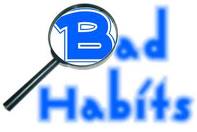Yesterday we looked at creating a Habits that Help Inventory. You can see the quick 5-step process here.
Today let’s take a look at habits that DON’T help. Why is that important? Because very often as we try to create new habits that help those old not-so-good habits (ok, BAD habits) show their ugly faces and stop us in our tracks.
How many times have you attempted to start doing something that’s really good for you, that’ll have you become more at peace, be more productive, create more prosperity for your yourself and others and you get on a good roll for a few days…then WHAM, along comes some habit that whispers in your ear “you know if you do me, it’ll feel good,” or “c’mon girl, you know you can take a quick break from all that ‘good behavior stuff’ do this thing, have some fun and go back to that stuff tomorrow.”
Some version of this happens to people every single day, all over the world…depending on who you are and where you live, it’s called distractions, bad habits, the power of evil, lack of focus, do what feels good, change is too hard, the devil, inner demons, satan at work, the power of the flesh, pleasure principle and on and on.
WHATEVER it’s called it’s the same thing happening. We get off an intended course of action and for some, never quite get back on.
Enough of this happening and a person can get down right disillusioned. You can get discouraged to the point of not thinking real positive change is really possible. People tend to think that bad habits are extremely powerful and breaking through them is just too hard.
I’m here to tell different. Well, not completely different because it is hard, bad habits are powerful BUT it’s not TOO hard and we are more powerful than the bad habits.
BELIEVE THAT! If you don’t believe that, it can’t be true in your life. You have to choose to believe that you have more power over your life than habitual routines.
So, let’s do an inventory of those habits that DON’T help.
First of all, it’s not really different from doing an inventory for habits that help. So if you didn’t check out yesterday’s post, please do so here. Follow those same 5 steps only this time let this be your prompt: The ineffective things I do routinely which take me away from achieving my goals are_____________________.
After following the 5 quick steps you will have a list of bad habits, now what do you do?
Take each group and see if you can find the causal relationship between them. Does one habit make another one inevitable? If you can identify these causal connections, you will be armed with some powerful information. The habit to go after is the one you believe makes it possible or even necessary for the others to exist. Let’s call that the ‘lead bad habit.’
Say for example you have several things written about self-sabotage…sleeping too late, going to bed too late, skipping exercise, too much TV viewing, negative thinking and self-blame…you can choose to stop doing all of these things at once, which could be very challenging (but doable.)
Or, you can opt to concentrate on what is probably the mother of self-sabotage: negative thinking and self-blame. It’s from there that we loose our sense of personal power. With no personal power it’s unlikely to do things we might be committed to but are not things that “feel” that good right away – like exercise, or earlier bedtime and so forth.
So find that ‘lead bad habit’ and focus your attention on that for the next few days. With the lead habit being broken down, you will experience a jolt of self-support that might surprise you. Be prepared for those distracting thoughts at the top…have a plan for them.
Armed with your inventory and knowledge of your lead bad habits you will be better equipped to work on creating new habits that help.
Suggestion: In creating a new positive habit that help… use positive language to yourself and others. Instead of “I’m not going to have negative thoughts of self-blame anymore,” say “I’m creating a habit of positive self-talk.” By speaking from the positive perspective we are sending a signal of action to the brain instead of one of inaction (what you WON’T do.) Our brain and nervous system works very well with clear directions of what we WANT IT TO DO.
Ok…have a good time with this exercise. Do it with a completely honest approach and you’ll get great insights on what is not working for you. Coupled with yesterday’s post on what is working, you can map out your approach to creating new habits that help.
Wishing you an abundance of joy and success,
♥~
